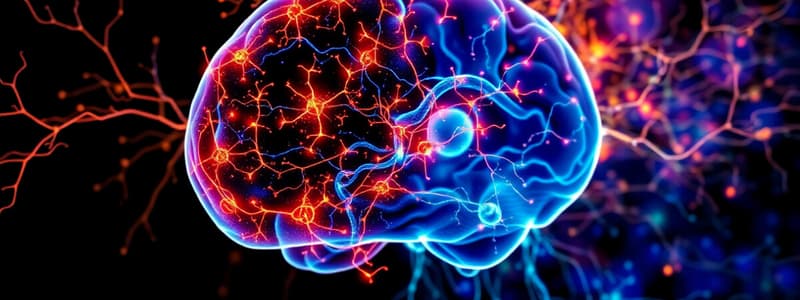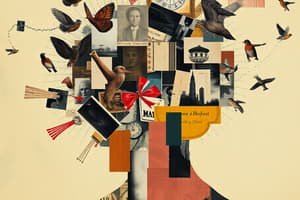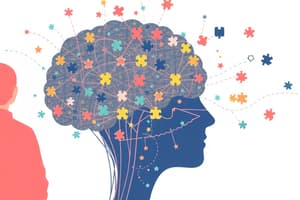Podcast
Questions and Answers
What aspect of Theory of Mind is suggested to be a key issue in autism according to Baron-Cohen?
What aspect of Theory of Mind is suggested to be a key issue in autism according to Baron-Cohen?
- Theory of mind deficit (correct)
- Ability to imitate actions of others
- Social communication skills
- Understanding others' emotions
In Iacoboni et al.'s study, which condition showed the greatest activity in the mirror neuron system?
In Iacoboni et al.'s study, which condition showed the greatest activity in the mirror neuron system?
- Moving the right index for a left 'x'
- Imitating the middle or index finger movements (correct)
- Moving the finger on which the x is displayed
- Moving the right middle finger for a right 'x'
What consistent finding was reported regarding individuals with autism in the context of imitation?
What consistent finding was reported regarding individuals with autism in the context of imitation?
- They readily imitate the actions of others
- They specifically imitate emotional expressions
- They imitate more than typically developing individuals
- They do not readily imitate the actions of others (correct)
In the EEG study by Oberman et al., what was measured to assess mirror neuron dysfunction?
In the EEG study by Oberman et al., what was measured to assess mirror neuron dysfunction?
Which of the following conditions did controls show greater activation for compared to individuals with ASD, as noted in Williams et al. 2006?
Which of the following conditions did controls show greater activation for compared to individuals with ASD, as noted in Williams et al. 2006?
In the study involving high-functioning children with autism, which condition did not show mu suppression in the participants?
In the study involving high-functioning children with autism, which condition did not show mu suppression in the participants?
What conclusion can be drawn from Cattaneo et al. (2007) regarding mouth muscle activation?
What conclusion can be drawn from Cattaneo et al. (2007) regarding mouth muscle activation?
What finding was reported in Dapretto et al. (2006) regarding the activation of the mirror neuron system?
What finding was reported in Dapretto et al. (2006) regarding the activation of the mirror neuron system?
Which theory is supported by evidence linking mirror neuron dysfunction and Imitation in autism?
Which theory is supported by evidence linking mirror neuron dysfunction and Imitation in autism?
What inconsistency in findings related to the mirror neuron system dysfunction in autism was mentioned?
What inconsistency in findings related to the mirror neuron system dysfunction in autism was mentioned?
What is the role of mirror neurons in the context of autism as proposed in the broken mirrors hypothesis?
What is the role of mirror neurons in the context of autism as proposed in the broken mirrors hypothesis?
According to the Direct Matching Hypothesis, what happens when an observer watches an action being performed?
According to the Direct Matching Hypothesis, what happens when an observer watches an action being performed?
What is a major limitation of the mirror neuron deficit theory in relation to autism?
What is a major limitation of the mirror neuron deficit theory in relation to autism?
What is the primary focus of discussions on action understanding as described in the content?
What is the primary focus of discussions on action understanding as described in the content?
What is the significance of the priming task in the study mentioned?
What is the significance of the priming task in the study mentioned?
What does the motor-simulation account struggle to explain according to the criticism presented?
What does the motor-simulation account struggle to explain according to the criticism presented?
According to the critique, what is necessary to select the correct motor chain for an action?
According to the critique, what is necessary to select the correct motor chain for an action?
What role does the parieto-frontal mirror mechanism play in understanding actions?
What role does the parieto-frontal mirror mechanism play in understanding actions?
Why might one simulate a different motor chain for the same observed action in varied contexts?
Why might one simulate a different motor chain for the same observed action in varied contexts?
What is considered a limitation of observing an action in isolation?
What is considered a limitation of observing an action in isolation?
Flashcards
Theory of Mind (ToM)
Theory of Mind (ToM)
The ability to understand that others have different thoughts, beliefs, and perspectives than our own.
False Belief Test
False Belief Test
A specific type of ToM test where participants must predict another person's actions based on their false belief about an object's location.
Mirror Neuron System (MNS)
Mirror Neuron System (MNS)
The neural basis of imitation, where neurons fire both when we perform an action and when we observe someone else performing it.
Imitation in Autism
Imitation in Autism
Signup and view all the flashcards
EEG Evidence of MN Dysfunction in Autism
EEG Evidence of MN Dysfunction in Autism
Signup and view all the flashcards
Echolalia
Echolalia
Signup and view all the flashcards
Echopraxia
Echopraxia
Signup and view all the flashcards
Direct Matching Hypothesis
Direct Matching Hypothesis
Signup and view all the flashcards
Action Understanding: Ambiguity & Context
Action Understanding: Ambiguity & Context
Signup and view all the flashcards
Mirror Neuron Theory: Intentions & Goals
Mirror Neuron Theory: Intentions & Goals
Signup and view all the flashcards
Mu Suppression
Mu Suppression
Signup and view all the flashcards
Broken Mirrors in Autism
Broken Mirrors in Autism
Signup and view all the flashcards
Action Imitation
Action Imitation
Signup and view all the flashcards
Increased Imitation in Autism
Increased Imitation in Autism
Signup and view all the flashcards
Motor Simulation Theory
Motor Simulation Theory
Signup and view all the flashcards
Ambiguity of Actions
Ambiguity of Actions
Signup and view all the flashcards
Non-motoric Context
Non-motoric Context
Signup and view all the flashcards
Outcome Prediction
Outcome Prediction
Signup and view all the flashcards
Understanding Precedes Simulation
Understanding Precedes Simulation
Signup and view all the flashcards
Study Notes
Broken Mirrors
- Theory of mind deficits are a key aspect of autism (Baron-Cohen).
- The same thoughts may not be shared due to differing knowledge bases.
- Imitation and mirror neurons might underpin theory of mind deficits.
- Simulation theory involves putting oneself in another's shoes, acting as if you are that other person.
False Belief Test
- A test for theory of mind is the false-belief task.
- 23/27 control participants (4;5 years old) passed the test
- 12/14 Down's Syndrome participants (10;11 years old) passed the test.
- 16/20 autism participants (11;11 years old) failed the test.
Imitation and Mirror Neurons
- Three different conditions were tested, involving index finger movements.
- Imitating movements where the position is marked with an 'x' (left index or middle finger).
- Activity in the mirror neuron system was greater in the first condition (comparing activity to baseline).
- The extra activity in the first condition is thought to relate to the mirror neurons coding of imitation.
- There are 21 experimental studies on imitation abilities in autistic individuals.
- Autistic individuals were found to struggle with imitating the actions of others.
EEG Evidence of Mirror Neuron Dysfunction in Autism
- High functioning autistic individuals and healthy controls (13 years old) were compared.
- Four conditions were used (watching visual noise, bouncing ball video, moving hand video, moving own hand), all related to the motor cortex.
- Controls showed mu wave suppression in conditions c) and d)
- Children with autism showed mu wave suppression only in condition d)
- Conclusion: Individuals with autism do not mirror hand movements.
- Mirror neurons, active in mouth opening muscles, were studied using MEG.
Atypical Social Modulation of Imitation in Autism
- Participants were asked to either place a piece of paper or food on their shoulder/mouth
- Typically developing children showed increased mouth muscle activity when watching another person reach for food.
- This response was not seen in children with autism.
- High functioning children with autism (age 12 years old), and typically developing children were tested.
- Children with autism had reduced activation of mirror neuron system compared to their controls.
- Participants asked to imitate different emotional expressions.
- The more severe autism, the less the mirror neuron system was activated.
Reduced activity in frontal mirror system during emotion imitation in children with autism.
• Theory suggests mirror neurons play a role in imitation and action understanding. • Imitation is impaired in autism, and this could possibly be due to a broken mirror system.
Other points
- Clinical observations suggest possible increased imitation in some aspects of autism.
- Echolalia and echopraxia are involuntary speech and action repetitions.
- Autistic individuals may show difficulties in inhibiting imitation of an action.
Studying That Suits You
Use AI to generate personalized quizzes and flashcards to suit your learning preferences.



